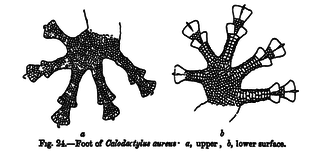
Calodactylodes is a genus of lizards, commonly called golden geckos, in the family Gekkonidae (geckos). The genus is distributed in peninsular India and Sri Lanka. Lizards in the genus Calodactylodes are primarily distinguished from other lizards by their characteristic, paired flower petal-like skin extensions on their fingers and toes.

Gehyra mutilata, also known commonly as the common four-clawed gecko, Pacific gecko, stump-toed gecko, sugar gecko in Indonesia, tender-skinned house gecko, and butiki in Filipino, is a species of lizard in the family Gekkonidae. The species is native to Southeast Asia. It has made its way to several areas of the world including Sri Lanka, Indochina, and many of the Pacific Islands. Compared to the common house gecko, the appearance of G. mutilata is somewhat plump, with delicate skin. The skin is usually colored a soft purplish/pinkish gray, with golden spots on younger specimens; these spots eventually fade with age.

Hemidactylus brookii, also known commonly as Brooke's house gecko and the spotted house gecko, is a widespread species of lizard in the family Gekkonidae.
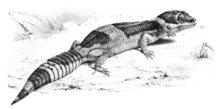
The East Indian leopard gecko, also known commonly as Hardwicke's gecko, is a species of gecko, a lizard in the family Eublepharidae. The species is endemic to India and Bangladesh.
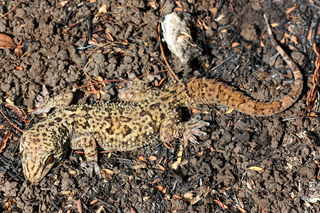
Hemidactylus maculatus, also known as the spotted leaf-toed gecko or giant spotted gecko, is a species of large gecko found in the Western Ghats of India and in parts of Sri Lanka.
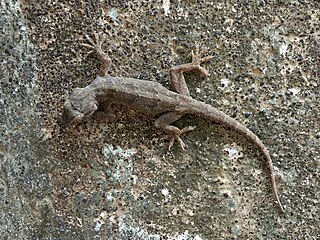
Leschenault's leaf-toed gecko is a species of gecko, a lizard in the family Gekkonidae. The species is endemic to South Asia and parts of West Asia. It is often found inside homes. Its scientific name commemorates French botanist Jean Baptiste Leschenault de la Tour.
Jerdon's day gecko is a species of gecko, a lizard in the family Gekkonidae. The species is endemic to India and Sri Lanka.
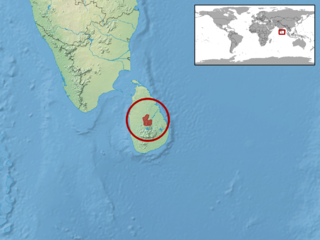
The Kandyan day gecko or Kandyan rock gecko is a species of diurnal gecko found in Sri Lanka.
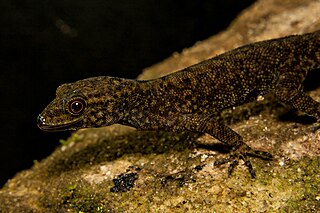
The Wynad day gecko is a species of gecko. It is endemic to the Western Ghats in Kerala, India, and only known from two locations, Wayanad and Silent Valley National Park.

Cyrtodactylus deccanensis, also commonly known as Deccan ground gecko, Günther's Indian gecko, or the banded ground gecko, is a species of gecko found in the northern Western Ghats of India. It has been found from northern Maharashtra, with a habitat range possibly extending to southern Gujarat. Cyrtodactylus albofasciatus was previously considered conspecific with Cyrtodactylus deccanensis but is now accepted as a valid species.
Cyrtodactylus nebulosus, also known as the clouded Indian gecko, is a species of gecko found in India.

The Malayan forest gecko or banded bent-toed gecko is a species of gecko found in Southeast Asia.
Lawder's bent-toed gecko is a species of gecko, a lizard in the family Gekkonidae. The species is endemic to northern India. Its type locality is "Kumaon", restricted to Almora by Malcolm Arthur Smith. It is named after Mr. A. Lawder who collected the holotype. His identity is not known for sure, but he is likely to have been A.W. Lawder who was a member of the Geological Society of London, as was Ferdinand Stoliczka who described the species. It is sometimes placed in the genus Cyrtopodion.

Cyrtodactylus jeyporensis, also known as the Jeypore Indian gecko, the Jeypore ground gecko, or the Patinghe Indian gecko, is an endangered species of gecko found in India, which was until recently considered extinct. Described from a single specimen in 1877, it was rediscovered in 2010 in the Eastern Ghats of Odisha state, India.
Hemidactylus karenorum, commonly known as the Burmese leaf gecko, the Burmese leaf-toed gecko, or the Burmese spotted gecko, is a species of gecko, a lizard in the family Gekkonidae. The species is endemic to Southeast Asia.

Hemidactylus persicus, also known as the Persian leaf-toed gecko or Persian gecko, is a species of gecko found in West Asia.
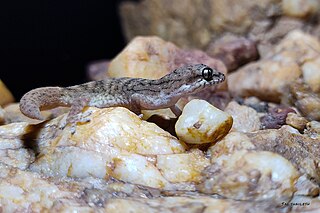
The reticulate leaf-toed gecko is a species of terrestrial, nocturnal, insectivorous gecko found in rocky areas of South India. It takes refuge under stones on ground during day time and emerges out at night for its activities.
Hemidactylus subtriedrus, also known as Jerdon's gecko or Madras blotched gecko, is a species of gecko found in India and Sri Lanka.

Hemidactylus triedrus, also known as the termite hill gecko, Dakota's leaf-toed gecko, or blotched house gecko, is a species of gecko found in South Asia. The race lankae of Sri Lanka, is now given species status and known as Hemidactylus lankae

The Southern Ghats slender gecko is a species of gecko with a restricted distribution in the hills of southern India.


















